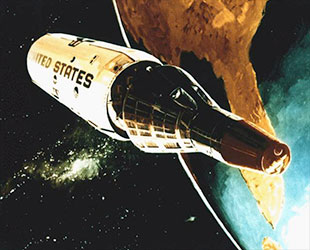June 2, 2005 —
A recent venture into a long-locked room at Cape Canaveral Air Force Station in Florida uncovered artifacts of a by-gone era: spacesuits for Americans who trained in the 1960s to be space spies, reports NASA on its website.
Two security officers were doing a check of the Launch Complex 5/6 museum, the former blockhouse from where the first American manned space flight was controlled. NASA Special Agent Dann E. Oakland and Henry Butler, Security Manager for Delaware North Parks and Resorts, discovered a locked room — and they did not have a key.
Using a master key for the facility, the locked door was eventually opened. With no power, the room had evidently not been in use by people in many years. The officers used flashlights to explore the room and make their find.
Oakland and Butler weren't the first visitors.
"During the turn over [from NASA to Delaware North] of the facility, the NASA/CCAFS Fire Department briefly accessed that room and discovered many, many reels of deteriorated film. The film had deteriorated so much that it was deemed a fire hazard concern," explained Oakland in response to an e-mail sent by collectSPACE.
Besides the film, Oakland and Butler found the two blue spacesuits "complete and in remarkable shape," as they were described by the suits' manufacturer who examined them.
"The suits were stored in their original shipping container with extra sets of gloves of various sizes," described Oakland. "The inside of the container's lid had the holder for the flight data files and a hand painted NASA logo."
"My first thoughts were to safeguard the suits to protect them from being destroyed or stolen," e-mailed Oakland.
Investigators began looking for who owned the suits. A NASA technician initially thought they were training units from the end of the two-man spacecraft Gemini Program or beginning of the Apollo lunar program.
The manufacturer, however, determined that they were MH-7 training suits from a short-lived Cold War-era military program to put a manned reconnaissance station in space.

Artist concept of the Manned Orbiting Laboratory (MOL). The white cylindrical element was the lab; the darker vehicle was a Gemini capsule to be used to bring crews to and from the lab. (NASA) |
Established in 1964, the Manned Orbiting Laboratory (MOL) was a U.S. Air Force initiative that would have sent USAF-selected and trained astronauts to a military- contracted space station in a modified Gemini capsule. After a few weeks in orbit, the crew would undock and return to Earth. The Air Force abandoned the program in 1969, but not before three groups of military officers had trained to be astronauts.
Of the two spacesuits, one labeled as number 008 had the name "LAWYER" on its left sleeve; Lt. Col. Richard Lawyer was a member of the first group recruited to be MOL astronauts in 1965.
Records show that NASA transferred ownership of Lawyer's suit to the Smithsonian Institution in 1983. It has now been returned to the Smithsonian.
No records were found for the other suit, identified with the spy-appropriate number 007. It still belongs to NASA, and the agency's plans for what to do with the spacesuit are still being determined.
"I would like to see suit 007 displayed at the Astronaut Hall of Fame in their Gemini display telling the story of the Manned Orbiting Laboratory program," wrote Oakland.
Other items of historical note were found in the room.
"Also in the room was a Space Shuttle main landing gear flown tire, miscellaneous launch pad electrical equipment from complex 5/6 and the film canisters mentioned," said Oakland.
The MOL program left other legacies to NASA, as well. When the program was canceled, seven of the younger astronauts were transferred to the agency's human space flight program and went on to have standout careers. Among them were Robert Crippen, pilot of the first Space Shuttle mission, and Richard Truly, who later served as NASA Administrator.
This article was updated. The update added quotes from NASA Special Agent Dann E. Oakland.
